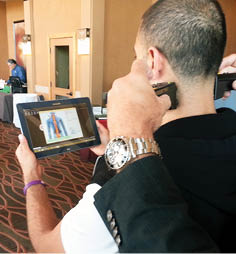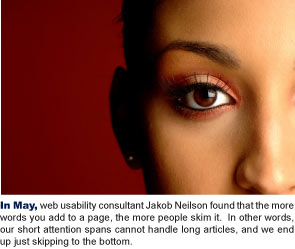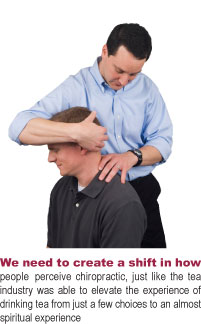:dropcap_open:G:dropcap_close:enerating new patients is a constant preoccupation for chiropractors. Unlike mainstream medical cohorts who enjoy a steady stream of sick and injured clientele, chiropractors must expend a tremendous amount of energy and resources to secure and maintain a viable patient base.

According to a survey conducted by Constant Contact, attracting new customers, engaging existing customers, and obtaining referrals are the top concerns for small businesses. The most effective means of accomplishing these goals required using e-mail marketing.1 As chiropractors, we too are small business owners.
Businesses across the board are changing their marketing strategies to focus on utilizing technology, the internet, and social media platforms. Relying on passive strategies (i.e., business cards or a Yellow Pages ad) worked extremely well in a thriving economy with a population of people who communicated verbally. This simply will not cut it in this tech-savvy smartphone era when patients trust information received electronically more than clever scripts born of the ’80s. The economy is no longer thriving, meaning it is time to adapt.
The silver lining of our current economic slowdown is the innovation that can come out of it. Industry leaders are creating products and services that mainstream chiropractic into our high-tech, connectivity-dependent society. Do you want to be truly effective? Meet patients where they live: on their smartphones. If you do so in a professional, ethical manner by providing impactful information that the patient considers valuable, then respect and growth will be your rewards.
The business card is dying, as are other print materials used for self-promotion. If people want to know who you are or find your phone number or address, they will Google you. In addition, direct mail is used less because the associated cost is higher, the return on investment is lower, and it is difficult to track the results accurately.
The fundamental concepts behind social media platforms have transformed the landscape of marketing. Innovations in technology are driving powerful changes in how individuals engage in health care delivery.2 These marketing mediums, combined with industry innovations, provide the chiropractor with the ultimate power to engage patients in their health recovery process, building stronger, long-lasting relationships. This has enabled chiropractors to cater to the needs of their patients rather than trying to mold patients to fit their practices, thus leading to true patient-centered care.
A patient-centered care environment inspires causal motivation that results in patients who want to comply with treatment programs and be the best they can be. People will work their hardest for something or someone in which they believe. Causally motivated patients tend to be advocates for their chiropractor and are great referral sources.
The “cause” in causal comes when providing patients with spinal specific data that they can use to justify the need for care. How often have you seen patients agree with your “paper and pencil” treatment recommendation yet never return or follow through? Too often for most, which is why it is critical to provide prospective patients with the evidence needed to overcome their fears and establish objectively the need for care. This is now commonplace and expected since every other venue of health care does it. Would you seriously let a dentist drill based upon his or her intuition or cleverly scripted “fear tactics”? Of course not, and neither will your untrusting prospective patients. Sadly, chiropractors ranked tenth in a recent Gallup poll rating honesty and ethical standards.3 Now you can use modern technology to combat this image.
Patients benefit greatly from evidence-based communication technologies, whether focused on general patient education, sEMG findings, specific condition information, or health and wellness topics. These tools reinforce the “why” of seeking chiropractic care and put this information in the hands of your advocates so they can easily share the information with others. Mobile devices present a tremendous opportunity to provide patients with even greater access to these powerful tools that support the current dynamic in healthcare delivery.4
To technologize your practice, consider implementing the following:
1. Retire the posters hung with tape or thumbtacks and invest in displays that can run a continuous loop of health and wellness
information oriented around your specific practice paradigm. Customize the reel to include video snips of the doctor and staff, simplified results of research studies, and pre- and post-exam results from devices like digital x-ray or static sEMG.
2. Incorporate technology into your examination, report of findings, and patient education efforts. Evidence-based, patient-centered tools will boost your credibility and provide your patients with the validation they need. Immediately integrate digital x-ray and sEMG/computerized range of motion. High-tech has become the expected norm within the evidence-based healthcare model. Providing objective data to substantiate treatment is an integral part of modern day health care.
3. Meet your patients where they live: on their smartphones. Take advantage of recent advances designed to help you connect on an entirely different level. Several consumer-friendly mobile applications have bolstered the chiropractor’s technology toolbox, including new applications that automatically send test results directly to patient’s smartphones.
4. Employ the efficiency of technology in your screenings, either in-house or at an event. By using modern technology like static sEMG to quickly show prospective patients their potential spinal concerns and then sending test data directly to their smartphones with your contact information, you increase the yield from screenings tenfold because they know how to reach you. Furthermore, you can utilize this technology to obtain e-mail addresses for further follow-ups and scheduling.
5. Make your website simple and clean, but most importantly “smartphone friendly.” The second patients hear about you, they go directly to your website on their smartphones. A site that is not smartphone friendly will be almost unreadable to the patient, possibly ending their interest with frustration.
6. Opt for practice management software that provides patients with a “portal” where they can complete patient forms, access their medical records, make appointments, and pay co-pays. Utilize practice software to the fullest with automated appointment reminders, newsletters, practice announcements, and e-vites.
Our society eats, breathes, and believes in technology. We don’t trust information unless it has been “blessed” by a computer of some sort and 80% of us are visual learners. So it’s understandable why the patient needs and wants visual confirmation. If you do so in a web- and smartphone-friendly manner, your practice will flourish.
Technology can be your best friend or worst enemy. By finding the best product and support for your needs, you will have a great partner in building your practice. Follow some simple guidelines and you will enjoy all the advantages of technology without the stress.
References:
1. Dornaus, Erika The Health and Wellness of Small Business, Constant Contact White Paper, May 2012.
2, 4. O’rourke, K., Heckman, J., Elwood, D. Development and Exploration of a Multifaceted Social Platform to Improve Patient Education, Communication, and Activity, Medicine 2.0 ‘12:Boston, USA, September, 2012.
3. Gallup Politics. Congress retains low honesty rating: Nurses have highest honesty rating; car salespeople, lowest. Newport, Frank. Dec 3, 2012
Dr. Nancy Miggins has over 25 year’s clinical experience as a chiropractor. She excelled in the areas of procedures, ethical business practices and management. After spearheading the development of a integrative health and fitness center, she spent 6 years as director of this clinic. Although her main focus was in family practice, she also has aided Olympic Athletes and professional cyclists with optimizing sports performance through chiropractic. She is currently the Director of Clinical Applications & Product Development for Precision Biometrics, Inc. Contact at : [email protected] or visit www.myovision.com or call 800-969-6961
David Marcarian, MA, founder of Precision Biometrics, and inventor of the revolutionary MyoVision 3G Wirefree PhysioMonitoring™ System. A former NASA researcher, Marcarian was awarded a $450,000.00 NIH grant to develop the MyoVision. As an expert witness, Marcarian was credited one of the largest PI awards in US history, and established the validity of sEMG in a major State Superior Court Decision. Recently the AMA selected his 3G Wirefree System as the “tool of choice” as presented in the medical text “The Practical Guid”. Contact at : [email protected] or visit www.myovision.com or call 800-969-6961
 According to a survey conducted by Constant Contact, attracting new customers, engaging existing customers, and obtaining referrals are the top concerns for small businesses. The most effective means of accomplishing these goals required using e-mail marketing.1 As chiropractors, we too are small business owners.
According to a survey conducted by Constant Contact, attracting new customers, engaging existing customers, and obtaining referrals are the top concerns for small businesses. The most effective means of accomplishing these goals required using e-mail marketing.1 As chiropractors, we too are small business owners.

 Allow me to take a step back for a moment. Before transferring to a new location, my previous practice benefitted from having access to a complete digital x-ray system – no film, no chemicals, no storage issues. Having the ability to take x-rays and have the results in seconds, and being able to annotate those x-rays, was simply part of how I worked with my patients on a daily basis.
Allow me to take a step back for a moment. Before transferring to a new location, my previous practice benefitted from having access to a complete digital x-ray system – no film, no chemicals, no storage issues. Having the ability to take x-rays and have the results in seconds, and being able to annotate those x-rays, was simply part of how I worked with my patients on a daily basis. 



 Dr. Steven J. Kraus is CEO of Future Health, Inc., a company that partners with chiropractors to deliver a comprehensive clinic management solution, including fullyintegrated EHR. Dr. Kraus is a recognized expert in building successful clinics, having developed and sold 18 practices of his own and provided strategic consulting services to more than 400 healthcare businesses. He offers leadership to numerous industry associations and currently serves as the Chairman of the Iowa Board of Chiropractic. Contact Dr. Kraus at skraus@Future- HealthSoftware.com for more information.
Dr. Steven J. Kraus is CEO of Future Health, Inc., a company that partners with chiropractors to deliver a comprehensive clinic management solution, including fullyintegrated EHR. Dr. Kraus is a recognized expert in building successful clinics, having developed and sold 18 practices of his own and provided strategic consulting services to more than 400 healthcare businesses. He offers leadership to numerous industry associations and currently serves as the Chairman of the Iowa Board of Chiropractic. Contact Dr. Kraus at skraus@Future- HealthSoftware.com for more information. 
 know, make the best new patients.
know, make the best new patients. Dr. Len Schwartz is a Fortune 500 trained marketer as well as the President and CEO of ChiroPractice Marketing Solutions,LLC, a marketing company that has been helping chiropractors build their practices since 1999. CPMS offers chiropractors over 65 turn-key, practicebuilding products and services, which nclude a fully research-based monthly patient newsletter. For more information, go to
Dr. Len Schwartz is a Fortune 500 trained marketer as well as the President and CEO of ChiroPractice Marketing Solutions,LLC, a marketing company that has been helping chiropractors build their practices since 1999. CPMS offers chiropractors over 65 turn-key, practicebuilding products and services, which nclude a fully research-based monthly patient newsletter. For more information, go to 


